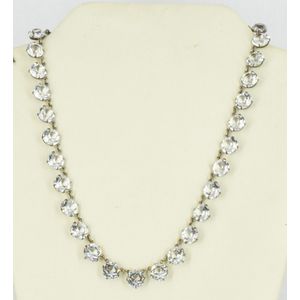Art Deco Sterling Silver Riviere Necklace with Paste Stones
An Art Deco riviere necklace, featuring round cut colourless paste on sterling silver. Weight 25.1g
You must be a subscriber, and be logged in to view price and dealer details.
Subscribe Now to view actual auction price for this item
When you subscribe, you have the option of setting the currency in which to display prices to $Au, $US, $NZ or Stg.
This item has been sold, and the description, image and price are for reference purposes only.
- Riviere - A riviere is a necklace made of a row of graduated single stones, usually diamonds.
- Paste / Rhinestone / Diamante - Paste (or rhinestone or diamante) is the name given to a coloured glass composition used for imitation gemstones, or to imitation gemstones made of glass.
Although the technique of glassmaking had been known for thousands of years, but it wasn't until a lead glass with similar optical properties to diamonds were invented by a German jeweller working in Paris (either "Stras" or 'Strasser") in the early 18th century that "paste" gemstones became popular.
There was no social stigma attached to wearing imitation stones, and they were worn in situations where highway robbery was a possibility. The 18th century settings were of very high quality, equivilent to real gemstone jewellery.
In the nineteeth century the quality of paste jewellery declined and it has remained the poor cousin to genuine gemstones ever since. - Art Deco Period - The Art Deco period was a cultural movement that emerged in the 1920s and 1930s, and was characterized by its emphasis on modernism, luxury, and elegance. The name "Art Deco" comes from the Exposition Internationale des Arts Décoratifs et Industriels Modernes, a large exhibition held in Paris in 1925 that showcased the latest trends in decorative arts.
Art Deco was a reaction against the ornate and elaborate styles of the previous era, and reflected a new modern sensibility. It was characterized by streamlined, geometric shapes, bright colours, and the use of new materials such as chrome, glass, and Bakelite. Art Deco designers sought to create a sense of luxury and sophistication, often incorporating expensive materials such as ivory, marble, and rare woods.
Art Deco had a significant impact on a wide range of artistic fields, including architecture, fashion, graphic design, and interior design. Some of the most iconic examples of Art Deco architecture include the Empire State Building in New York City, the Hoover Building in London, and the Palais de Chaillot in Paris.
The Art Deco period came to an end in the 1940s, as World War II and changing cultural trends led to a shift in artistic styles. However, Art Deco remains an important influence on design and art, and continues to be celebrated for its modernist sensibility and glamorous aesthetic. - Sterling Silver - Sterling silver is a mixture of 92.5% pure silver and 7.5% of another metal, usually copper. Fine silver is 99.9% pure silver, and is relatively soft and the addition of the very small amount of copper gives the metal enough strength and hardness to be worked into jewellery, decorative and household objects.
This item has been included into following indexes:
Visually similar items

A pearl necklace, blue pearls with a 14ct yellow gold clasp. Length 20 cm.
Sold by
in
for
You can display prices in $Au, $US, $NZ or Stg.

A 1920s necklace, set with colourless stone, on silver mounts. Length closed 19 cm.
Sold by
in
for
You can display prices in $Au, $US, $NZ or Stg.

A sterling silver necklace, featuring off-round beads. Length 24 cm. Weight 62.7g.
Sold by
in
for
You can display prices in $Au, $US, $NZ or Stg.

A lapis lazuli necklace, graduated round beads of approx. 7-14 mm on silvered clasp.
Sold by
in
for
You can display prices in $Au, $US, $NZ or Stg.
